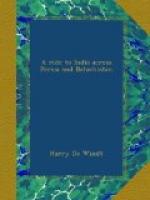The sacred city of Koom [D] is one of the pleasantest recollections I retain of the ride between the capital and Ispahan. It was about two o’clock on the afternoon of the 6th of February that, breasting a chain of low sandy hills, the huge golden dome of the Tomb of Fatima became visible. We were then still four miles off; but, even with our jaded steeds, the ride became what it had not yet been—a pleasure. The green sunlit plains of wheat and barley, interspersed with bars of white and red poppies, the picturesque, happy-looking peasantry, the strings of mule and camel caravans, with their gaudy trappings and clashing bells,—all this life, colour, and movement helped to give one new hope and energy, and drown the dreary remembrance of past troubles, bodily and mental. Even the caravans of corpses sent to Koom for interment, which we passed every now and again, failed to depress us, though at times the effluvia was somewhat overpowering, many of the bodies being brought to the sacred city from the most remote parts of Persia. Each mule bore two dead bodies, slung on either side, like saddle-bags, and one could clearly trace the outline of the figure wrapped in blue or grey cloth. A few of the friends and relatives of some of the deceased accompanied this weird procession, but the greater number of the dead had been consigned to the care of the muleteers. The latter, in true chalvadar [E] fashion, were stretched out flat on their stomachs fast asleep, their heads lolling over their animals, arms and legs dangling helplessly, while the caravan roamed about the track unchecked, banging their loads against each other, to the silent discomfiture of the unfortunate mourners.
[Illustration: A CORPSE CARAVAN]
Koom is said to cover nearly twice as much ground as Shiraz, but more than half the city is in ruins, the Afghans having destroyed it in 1722. The principal buildings are mainly composed of mosques and sepulchres (for Koom is second only to Meshed in sanctity), but most of them are in a state of decay and dilapidation. The mosque containing the Tomb of Fatima is the finest, its dome being covered with plates of silver-gilt—the natives say of pure gold. The sacred character of this city is mainly derived from the fact that Fatima, surnamed “El Masouna” ("Free from sin"), died here many years ago. The tradition is that Fatima was on her way to the city of Tus, whither she was going to visit her brother, Imam Riza. On arrival at Koom, she heard of his death, which caused her to delay her journey and take up her residence here for a time, but she shortly afterwards sickened, and died of a broken heart. A mausoleum was originally built of a very humble nature, but, by order of Shah Abbas, it was enlarged and richly ornamented inside and out. Fatti-Ali-Shah and Abbas the Second are both buried here; also the wife of Mahomet Shah, who died in 1873, having had the dome of the mosque covered with gold. There is a legend among natives that Fatima’s body no longer lies in the mosque, but was carried bodily to heaven shortly after death.




